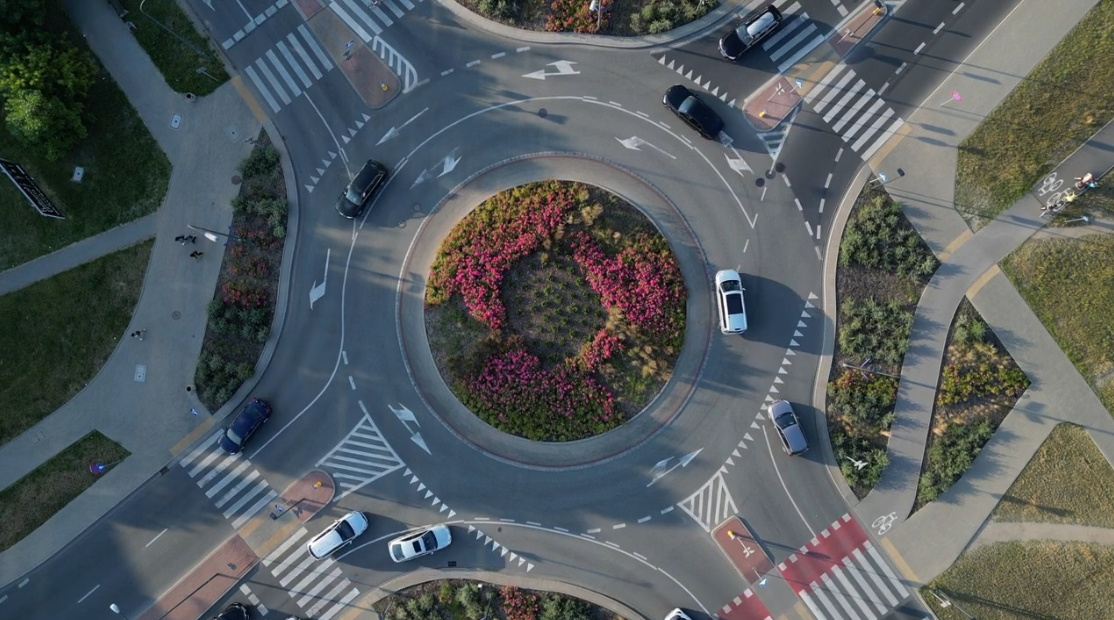
Picture this: you are driving to work and are about to be late. All the traffic signals so far have been green, but the next one is the most important; it has a four-minute wait time if you miss it, to accommodate the influx of traffic coming in perpendicular to you. You speed up, rushing to reach it in time, but it turns yellow just before you are close enough, and any chances of passing it are out of your reach. It’s almost as if this situation could have been avoided if there were a method for traffic to flow simultaneously in all directions. Luckily, there is.
Traffic circles—also known as roundabouts—are an ingenious solution for accommodating traffic at road intersections. There are two simple rules: once you enter the inner circle, you must travel counterclockwise until you reach the road you want to turn onto; all incoming traffic must yield to those driving in the inner circle. Think of it as a highway coiled into a circle; you yield to oncoming cars, you enter at a certain point, and you leave when you reach your designated destination or exit.
Traffic circles are safer than intersections. Studies conducted in 2001, 2004, and 2007 in the United States all found that the number of injury crashes has fallen by 72% to 80%, and the number of total crashes has fallen by 35% to 47%. Admittedly, there are some concerns with traffic circles, with one of the major ones being the large circular shape in the middle. If an unsuspecting car is driving too fast, it risks driving into this concrete obstacle. To combat this, signs warning people about an upcoming traffic circle are placed well in advance. Despite this, if someone comes hurtling down the road at speeds far too high, there is not much anyone can do about that.
The history of the traffic circle is said to begin as far back as the 18th century in parts of Western Europe and America, when evidence first emerged of circular-shaped intersections where roads met. The first real application of a traffic circle is credited to an American named William Phelphs Eno, whose Columbus Circle was built in New York in 1903. By the 1930s, the idea of integrating traffic circles into actual roads had become more and more prevalent. However, there was one small issue: no one could agree on how to make it mesh well with current roads. As a result, no real progress was made until the 1960s, when the “modern roundabout” became a part of road networks. (Poland) After waiting for three whole decades for the traffic circle to become a functional part of the United Kingdom’s networks, the U.S. finally decided to construct its first in Summerlin, Nevada, in 1990. After that, even as traffic circles became increasingly popular in parts of Europe and Australia, the U.S. still had some trouble digesting the idea.
This brings about the burning question: if traffic circles are so good, why aren’t they more popular in America? The answer to that question goes all the way back to the 1950s, the time when most of the US states agreed on scrapping the idea of traffic circles and going with the innovative idea of traffic signals. With the introduction of this new technology, many deemed traffic circles as obsolete methods of handling traffic.
As mentioned earlier, parts of Europe (especially the United Kingdom) and Australia have welcomed the concept of traffic circles with open arms, integrating them seamlessly into their complex web of streets and roads. Some famous displays of traffic circles in the United Kingdom are Swindon’s Magic Roundabout, the Crooked Billet Roundabout, and Staples Corner. As for Australia, the numbers speak for themselves: in Canberra alone, there are 406 roundabouts and 276 sets of traffic signals.
In conclusion, traffic circles deserve far more appreciation than they receive. They improve safety, reduce the number of gridlock occurrences, and use no electronic resources whatsoever. While it may not be the primary concern to most, the integration of the traffic circle into American road networks would greatly benefit many people.